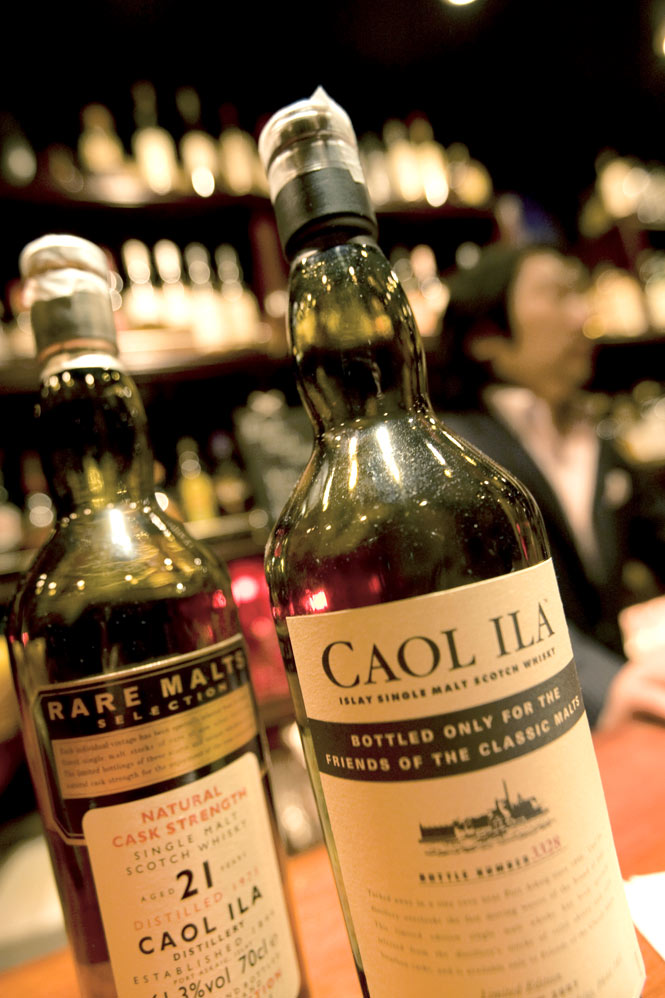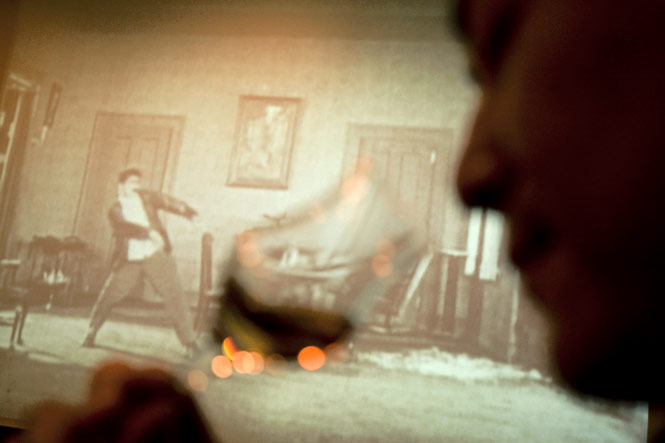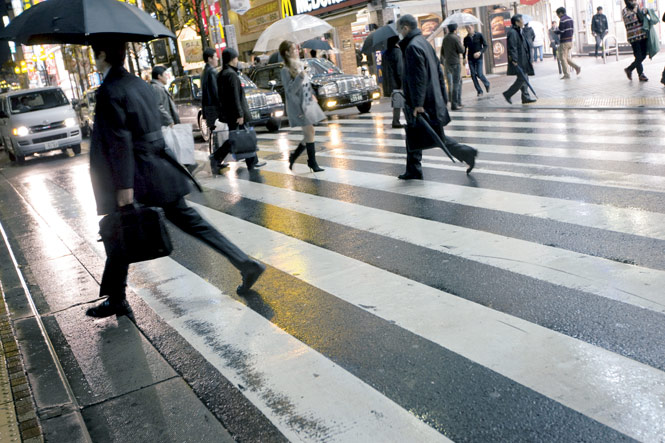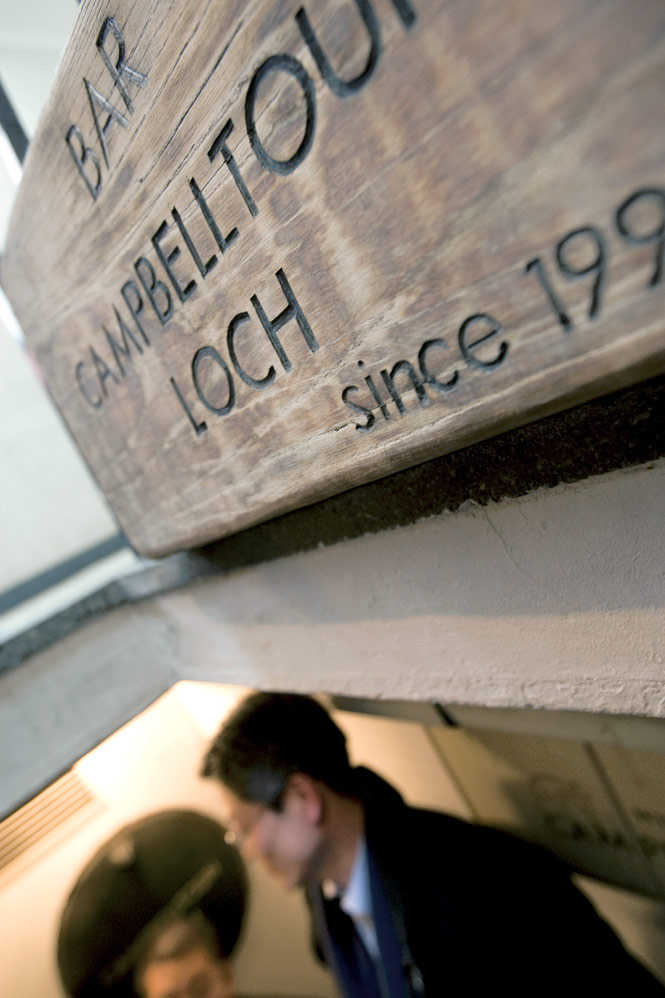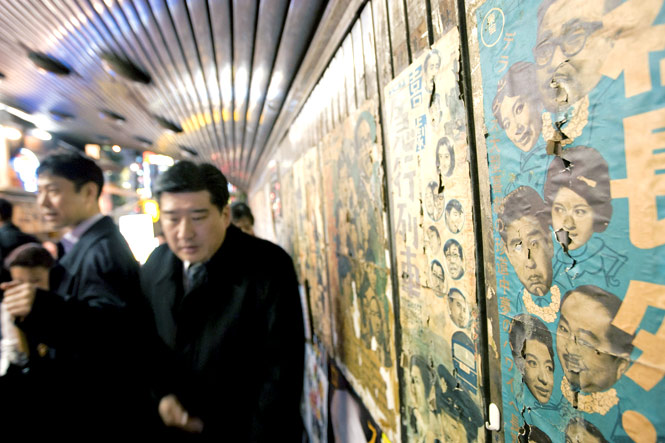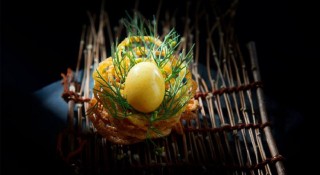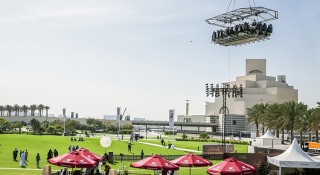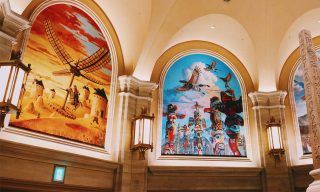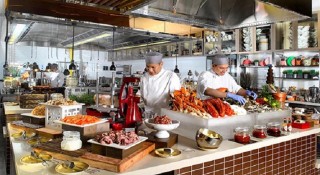Above: The Helmsdale’s well-traveled Masaki Murasawa.
With its impressive range of specialty bars and single malts, Tokyo’s whisky scene is, according to local aficionados, second to none.
By Stephen Phelan
Photographs by Jeremy Sutton-Hibbert
It is raining hard in Tokyo this afternoon, but we are far enough underground to forget about the weather for the moment, like those deep-sea fish who don’t know or care what’s happening at the surface. The Japanese capital is effectively a split-level city, where you could probably walk for days without emerging from its endless basement of subway stations, shopping arcades, and streets beneath the streets.
Somewhere down here, below Tokyo Station, is a specialist whisky shop called Liquors Hasegawa. Yoichi Motoki guides us there, along crowded corridors at rush hour. Yoichi is a former bartender who took a job with the importer and distributor Whisk-e Ltd., and went to work for a couple of years at a distillery on Scotland’s blustery Isle of Arran, not far from my onetime home in Glasgow. He knows the CalMac ferry timetables at least as well as he does Tokyo’s train schedule, and shares his first name with the Japanese single malt that was voted best in its class at the 2008 World Whiskies Awards, though he laughs this off as a happy coincidence.
His employer, David Croll, has also come along; the CEO of Whisk-e Ltd. will be my interpreter by default. A very tall Englishman who only seems more so in Japan, David agrees with the resident aficionados who believe that Tokyo is now the greatest city in the world for drinking whisky, whether single malts or blends, foreign or domestic. “I don’t think even the people who live here quite realize how much is going on,” he says.
Although generally distilled to Scottish specifications, roughly 80 percent of the whisky sold in this country is homegrown, produced by the drinks giants Nikka and Suntory or by a few independents. At Liquors Hasegawa, that rule is basically reversed—almost all of their stock is original Scotch, and it rises to the ceiling in the pleasing antiquarian way of books in classical libraries. Employees need stepladders to reach the remotest bottles.
Manager Shusaku Osawa has worked here for 25 years, long enough to watch McDonald’s and Starbucks move in on either side of him, and to see Scottish single malt become affordable, if not exactly cheap. “Some of our customers are getting quite old,” says Osawa, relying on David to translate and paraphrase. “And a lot of those tend to be traditional blend drinkers, who stick with the same label they’ve always bought.”
Many such loyalist tastes were formed in the brief golden age of the 1980s, when Japan’s world-beating brand of capitalism conspired with Margaret Thatcher’s protectionist prices to ensure that only captains of industry could pay for higher-end Scotch, which then became a badge of prosperity. Tax and trade changes in the following lean decade eventually led to the cost of a bottle dropping under 10,000 yen (US$110, more or less).
Now, younger customers want and get the single malts that their elders were largely denied. According to Osawa, they are “promiscuous” in their purchases. For the last couple of years, he has offered tasting samples from his ever-widening range, starting at a bargain 100 yen per dram—although two is your limit. Already predisposed to trust a man who wears the black apron of a true shopkeeper and the esoteric beard of an artisan, I try his recommended 1996 Clynelish, specially bottled for Liquors Hasegawa by a visiting importer. And I might even buy it if not for the yen’s pitiless exchange rate.
“Banzai!” shouts Osawa, albeit discreetly, when asked if his regulars have been similarly intimidated by the economic downturn. He is the first Japanese person I have ever heard use that word outside of war films or TV game shows, and with David off browsing at the back of the shop, I can only guess that he means their love of whisky is recession-proof, perhaps to the point of outright defiance.
Yoichi leads us back out into heavy foot traffic, and we take a packed train to Shinjuku. Out at street level, the district looks like a digital construct, especially in the rain, with sliding blocks of neon diffused through a canopy of translucent commuter umbrellas. The sight of it famously inspired the set designs for Ridley Scott’s Blade Runner. Zoetrope, a small whisky bar on the third floor of a nearby high-rise, is cinematic in its own way, but willfully unfuturistic.
Owner Atsushi Horigami screens silent-era comedies through a projector while serving the finest and rarest products of Japanese distilleries. The black-and-white antics of Buster Keaton and Charlie Chaplin don’t usually run in sync with Horigami’s musical loop of random soundtracks from very different films, like the Vietnam drama Born On The Fourth Of July. He used to work in film production himself, before quitting to open a place that would combine his two passions. (“Passion,” David tells me more than once tonight, “is the big thing these days.”)
Zoetrope was named after the mechanical device that made the earliest movies possible—Horigami keeps one behind the bar—which in turn comes from a Greek word meaning “wheel of life.” Horigami doesn’t speak English, let alone Gaelic, but he does know that uisge beatha translates to “water of life,” and imagines a connection between water and wheel that he finds difficult to explain. Even so, you won’t find any Scotch here.
“Scotch, Scotch, Scotch,” says Horigami of most other whisky bars in Tokyo, having dedicated himself to sourcing and pouring the best of his own country. He drives out to family liquor stores in rural towns, scours the dustiest shelves for what the owners consider “dead stock,” and returns with long-forgotten bottlings that his most informed and obsessive patrons have never seen or heard of.
Since Horigami’s rivals caught on to this trick, there have been fewer buried treasures to find, but even his better-known stuff is brand new to me. I ask for a glass of Suntory’s Special Mysterious Whisky purely because of the name. It’s a 12-year-old malt made for a Japanese crime-writers’ association. “Not particularly mysterious,” as David puts it after a sip, but not at all bad. Nikka’s Peaty and Salty lives up to its label more aggressively. Being only semi-conversant in the language of tasting notes, I would actually call this one “murderous at the attack.”
That language has become an issue, David tells me on the taxi ride across town to Minami-Aoyama. Until recently, British whisky jargon has been imposed on the Japanese, but standard terms like “smoky” or “peaty” or “sherried” don’t mean quite the same things here. Local distilleries are apparently developing new frames of reference for Japan’s own tastes and palates, which might compare certain whiskies to seafood, sauces, or candies that native drinkers will recognize more naturally.
In the Helmsdale, however, the menu is strongly Scottish-inflected: fish and chips (though the cod comes from Hokkaido); chips and cheese; haggis in Talisker; whisky-flavored pasta with salmon, cream, and Johnnie Walker. Yoichi orders several plates to share, which is customary, almost compulsory in Japanese pubs, and a round of real ales from the Yona Yona brewery in Nagano. The manager, Masaki Murasawa, serves us personally, wearing an “I Islay” T-shirt.
Murasawa has visited more than 50 distilleries in Scotland, and believes that our two countries share the same “kindly, friendly spirit.” It is not entirely possible to forget which land his establishment is in, but there is a peculiar dislocation that comes of half-watching a Celtic Football Club match on television while drinking a nine-year-old single cask Kingsbury’s Caol Ila in a Tokyo bar decorated with saltires and stag antlers. Feeling a little unmoored, I have a vision of this session ending with my singing “Caledonia” through strangled nostalgic sobs.
A computer programmer named Yoshi helps bring me back to reality, having just forked out 5,000 yen (about US$56) for a single dram of 40-year-old Highland Park. Yoshi tells me that he comes to the Helmsdale twice a week, but only once a month, on payday, does he ask Murasawa for a special recommendation, no expense spared. Tonight is that night.
“I can’t fight the attraction,” he says. “White Bowmore, Black Bowmore … I try but I always lose.” Might the current economic gloom not persuade him to budget? “It’s getting more difficult for me,” he admits. “But still not impossible.” Over at Campbelltoun Loch, a pint-size basement space that seats no more than nine people at a time, another customer informs me in excellent English that he “cannot finish a day without a Scotch malt.” Tsuyoshi Komori keeps 500 bottles at home for that purpose.
Judging by his business card, Komori is some kind of financier. “But if you have 500 bottles, it means you don’t have much to deposit in the bank,” he says. “I translate my money into memories instead.” I ask if his wife shares his passion. “No. But she understands.” And how does he decide which of his many malts to drink each night? “Instinct.”
Komori and his friends represent the avant-garde of the Tokyo whisky scene. They are wataku—geeks, or purists if you prefer—who always order it neat, never mizuwari (mixed with water). They are also nomadic, David explains, and Campbelltoun Loch is currently their favorite bar precisely because the owner, Nobuyuki Nakamura, does not have enough room for anything superfluous, generic, or substandard.
I can see why they trust him. Inquiring as to my tastes, Nakamura chooses for me. If he hadn’t, I might never have heard of Douglas Laing’s Old and Rare 30-year-old, from the long-defunct Port Ellen distillery, or realized how badly my life has been lacking it.
It’s a similar scene at the Mash Tun, situated down a side street near Meguro Station. Proprietor Toru Suzuki is also a frequent visitor to Scotland, where he picks up stock—including a 1967 Longmore and a lush 20-year-old Pittyvaich from Speyside—to add to his near-exhaustive range of single malts. With bare concrete walls and just a few tables, Suzuki’s snug little bar attracts a steady stream of regulars.
Just for the sake of contrast, Yoichi insists that I take a shot of denki bran when we make a brief stop at Manpuku Shokudo, a noisy izakaya pub under the Ginza railway tracks. This potent, brandy-based liquor debuted in Tokyo in the late 19th century and became especially popular after World War II, when little else in the way of cheap alcohol was available to denizens of the ruined city. Modern Tokyoites must still drink it so as not to forget, because even now it tastes like utter despair to me.
At the other end of the scale, in a dark and beautiful cocktail bar called Ginza S, we order our last round of the night. Mixed with fresh fruit and Lochranza by an expert known as CJ (his real name is Seiji, but folks on the Isle of Arran couldn’t pronounce it when he, too, worked in the whisky trade there), they might be the best cocktails I will ever have; they’re certainly the most expensive. The bill for three comes to more than US$250.
Knowing that I could never afford another, I head back out into the rain—warmed, at least, by the water of life.
ADDRESS BOOK:
Whisky in Tokyo
- Campbelltoun Loch
B/F, Matsui Bldg., 1-6-8 Yurakucho, Chiyoda-ku; 81-3/3501-5305 - Ginza S
B2/F, Kaitou Bldg., 7-5-4 Ginza, Chuo-ku; 81-3/3573-5074 - Helmsdale
2/F, Minami-Aoyama Mori Bldg., 7-13-12 Minami-Aoyama, Minato-ku; 81-3/3486-4220 - Liquors Hasegawa
North Exit, Yaesu Underground Mall, Tokyo Station, 2-1 Yaesu, Chuo-ku; 81-3/3271-8747 - Mash Tun
2/F, 2-13-3 Kami-Osaki, Shinagawa-ku; 81-3/3449-3649 - Zoetrope
3/F, Gaia Bldg., 7-10-14 Nishi-Shinjuku, Shinjuku-ku; 81-3/ 3363-0162
Originally appeared in the April/May 2010 print issue of DestinAsian magazine (“Spirited Away”)



